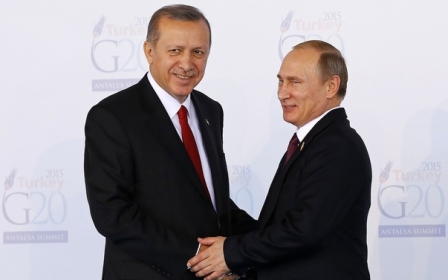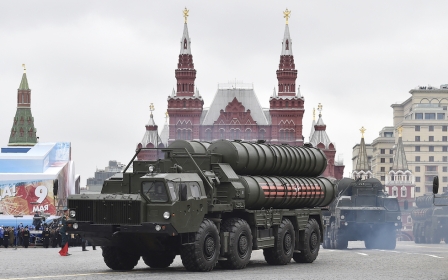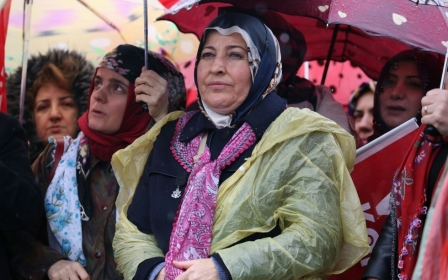Istanbul's Grenfell? Hospital fire brings city safety into stark relief
ISTANBUL, Turkey – Within seconds, flames had engulfed the side of a 14-floor hospital in the heart of Istanbul. Within minutes, panic had set in. But alarm bells had been ringing for years over the almost total unpreparedness of this city of 16 million people to deal with fires and other disasters.
Highly inflammable exterior cladding has been cited by many experts as the reason behind the rapid spread of the hospital fire in central Istanbul on 5 April.
The inexpensive but faulty material used in the cladding, especially in a hospital, was not even an oversight. The same cladding on the same building went up in flames in 2011 while it was still under construction.
More than half of Istanbul's buildings have similar low quality and highly inflammable cladding
- Battal Kilic, Istanbul president, Chamber of Mechanical Engineers
The stakes are even higher considering that Istanbul sits on an active fault line and is highly vulnerable to earthquakes. Fires pose a major threat after earthquakes and such poor-quality exterior cladding could add immeasurable damage.
"More than half of Istanbul's buildings have similar low quality and highly flammable cladding," Battal Kilic, the Istanbul branch president of the Chamber of Mechanical Engineers, told Middle East Eye.
The chamber operates under the Union of Chambers of Turkish Engineers and Architects (TMMOB), a professional body.
Kilic said unsuitable cladding was preferred by contractors because it was cheaper by at least a third.
"The hospital fire seems to have broken out either in a rubbish bin outside the building or on one of the top floors in an air conditioning unit. It wouldn't have spread so quickly and become such a huge risk if the building had proper cladding," he said.
Grenfell-style disaster in the making
If not for Istanbul's firefighters and staff at the Taksim First Aid and Research hospital, Istanbul might have experienced a disaster similar to that which befell the Grenfell tower in west London, another cladding-fuelled blaze which killed scores of its residents.
Contractors and developers looking to cut costs, combined with a complete lack of supervision and regulatory control is behind the dire state of affairs in Istanbul, according to Kilic.
"The quality control engineers are paid by the contractors so how can they be expected to write honest reports. There is no independent or government inspection," said Kilic.
"The laws and regulations exist but the supervision to make sure they are implemented is nowhere to be seen."
It is not just buildings but also basic infrastructure that pose a risk due to dubious construction.
On 27 February, a gaping hole emerged in a moving escalator at a relatively new metro station. One person fell through it and was seriously injured. The Istanbul municipality suggested the passenger was to blame for the incident.
Signs of disrepair are clearly visible at some of these relatively new stations. Many new lines and stops were added to the city's public rail networks in the last decade.
Experts are divided over whether these are the result of rushed and shoddy finishing or deeper-lying issues.
After the Marmara earthquake of 1999 that devastated the nearby industrial town of Izmit and left more than 18,000 people dead, a shocked Turkey started seriously considering measures to be better prepared.
One of those measures was urban regeneration projects throughout the country, but primarily focused on Istanbul.
It was meant to replace old unsuitable buildings with properly constructed ones, but even more to ensure proper city planning and provide for much-needed spaces and services during emergencies.
Victims of greed
To Kilic, the entire project became a huge fiasco where greed and profits overtook all other concerns.
Many of the structures built after tougher laws were introduced often still lack the most basic emergency measures, such as fire exits.
"It was an unequalled failure. You have 20- to 30-storey tower blocks in areas only suitable for buildings of maximum six floors. None of them have been through proper inspection either," Kilic said.
Murat Balamir, a retired professor from Ankara's Middle East Technical University and a city and regional planner, told MEE that Istanbul would require at least 15-20 years to prepare itself for an earthquake.
Balamir was planning director of the Istanbul Earthquake Master Plan project presented in 2003. He said the plan was sound and needed proper implementation but unfortunately that never happened.
The urban regeneration projects were part of the master plan and Balamir said they would have been a success in their original form.
"Our urban regeneration plan didn't exclude low-income groups. How can you do that if you are planning for disasters? But what emerged from parliament as legislation was different from what we submitted," said Balamir.
Balamir and his colleagues faced opposition from one set in particular: the construction industry, contractors and architects.
He said his focus as a city planner was on wider areas and making provisions on the basis of available spaces and their feasibility in terms of proper disaster management planning.
But the construction industry and contractors had no interest in that, instead claiming a well-built building was the best precaution against earthquakes.
Big business trumps safety
The construction industry is a major driver of the Turkish economy and, according to Balamir, "wielded immense clout with the government".
"As city planners we had developed plans on a much broader scale featuring the entire city but the contractors and architects didn't agree and preferred to focus on individual buildings," he said.
Balamir said Istanbul residents were literally made to forget all about earthquake risks, in large part due to the ill-advised actions of former Istanbul mayor, Kadir Topbas, who was in office from 2004 to 2017.
It wasn't even until the 2011 earthquake in the south-eastern city of Van that the topic started being mentioned again, said Balamir.
The World Bank didn't care about proper preparedness. All it was interested in was recouping its credit as soon as possible
- Murat Balamir, retired city planner
Balamir also pointed the finger at international organisations for the state of unpreparedness Istanbul finds itself in today.
The Turkish government in 2005 initiated the Istanbul Seismic Risk Mitigation and Emergency Preparedness Project (ISMEP). As part of the project, the government leveraged $1.5bn from bilateral donors and multilateral development banks. Of this sum, $550m was through World Bank financing.
"The World Bank didn't care about proper preparedness. All it was interested in was recouping its credit as soon as possible," said Balamir, who was in the know of the circumstances surrounding the deal.
"It would take 15-20 years if we were to start from scratch now and try to get Istanbul in shape in terms of disaster preparedness," he added.
Kilic said the first visible step had to be the creation of independent regulators who will provide proper oversight.
"Many people and bodies are responsible for the situation where even hospitals catch fire so easily. Municipalities, mayors, politicians, contractors, the list goes on. But not one of them will admit responsibility nor can they be held to account."
New MEE newsletter: Jerusalem Dispatch
Sign up to get the latest insights and analysis on Israel-Palestine, alongside Turkey Unpacked and other MEE newsletters
Middle East Eye delivers independent and unrivalled coverage and analysis of the Middle East, North Africa and beyond. To learn more about republishing this content and the associated fees, please fill out this form. More about MEE can be found here.






